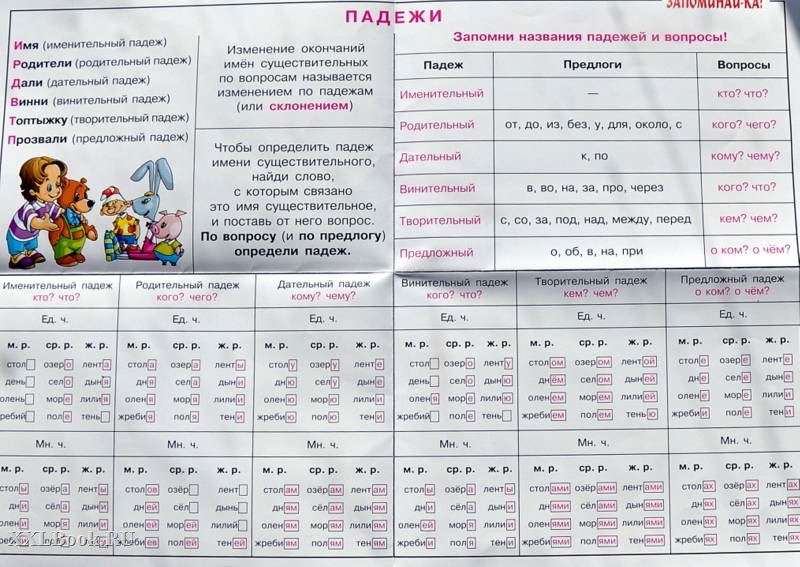How to identify Russian Pades: Detailed table with questions
All world languages \u200b\u200bcan be divided into flexive and tube. This means that the words included in the language of the first group have the endings, and the lexical units belonging to the second group of languages \u200b\u200bdo not have them. Russian refers to the first type of languages. This is explained by the fact that words in their native language in the proposal and phrases are associated with meaning and grammatically, that is, with the help of endings.
The end of the registered parts of speech is indicated in what case the desired part of speech is used. In general, the category name in Russian has such a grammatical sign as a case. It is he who allows you to associate lexemes in phrases, and phrases in the sentence, that is, larger units of the expression of thought.
It is customary to refer to one of the morphological signs of registered parts of speech. It is intended to ensure grammatically, it was possible to determine what kind of relationships are the components of the phrase or
The category of the case of the noun is defined as a sign that is included in the group of morphologically non-permanent. When the part of the speech changes its case. In general, in Russian allocate six cases. They are included in the student as part of the school program.
- Non-identity - this is a case, in which the name of the noun is in the form of units. For comparison: lilac (what?), child (Who?). The noun in this I. p. Never uses in speech with a pretext. For this reason, I. p. Is direct.
- Genitive. Indirect. It is always consumed with pretexts. It is possible to check the auxiliary word "no". For example: (No who?) Misha.
- Dative. Auxiliary word - "Dame". Indirect, its use is possible without an excuse and with him. Example: (I will give someone?) Nikita.
- Accusative. Helps correctly defining his word "see". Indirect. Nouns in V.p. are additions in the proposal. According to the above features, it is not confused with the very famous. For example: Through (what?) time, (I see what?) banner.
- Instrumental. For him, the auxiliary word will be "satisfied." Indirect. It is used with. Example: (pleased with whom?) daughter, (satisfied with what?) Result.
- Prepositional. Indirect. His name directly suggests that it is always used with the pretext. The auxiliary word "I think." For example: (I think about whom?) about beloved; (think about what?) on Protection of Dissertations.
Table of Padgers of the Russian language with questions:
Paddy system
 It turns out that the pelvic system of our native language is represented by fifteen podges. Six of them are studied in the know. And about the rest let us go further.
It turns out that the pelvic system of our native language is represented by fifteen podges. Six of them are studied in the know. And about the rest let us go further.
- Vocative. He was part of the Padel System of the Old Slavonic language. Now it can be considered the word God. Today, similar forms in the language are formed when fillection cut off. It turns out not quite "full-fledged" in the grammatical sense of the word: Mom, Bab, Dad And the like forms.
- Local. It is easy to guess by predictors in, on, with And on the question where?: (Where?) with shelf, (Where?) On Chiffonier, (Where?) in the nose.
- Dividing. It is a derivative of the form of a genitive. Determined in context. For instance: to drink tea, there will be no light, with heat with heat.
- County. The indicator is the word indicating the number or number in the context: two hours, two steps.
- Squeezing. It is used with the pretext of. It has the start of the movement. For instance: from house etc.
- Listening. Learn it easily by context. Always used with a particle not. For example: can't have a child.
- Standing. It looks like the accusative one. It is possible to determine it only in context. For instance: wait from the sea weather.
- Precientive or incoming. He also recognizable in context. For example: I will be in my wife, it is good in my daughteretc.
How to define
 The definition of a grammatical category, for example, the case of nouns and their endings, schoolchildren should be able to perform both verbally and writing.
The definition of a grammatical category, for example, the case of nouns and their endings, schoolchildren should be able to perform both verbally and writing.
First, consider the algorithm where you can verbally determine the case:
- In the proposal, it is necessary to allocate such a phrase so that the nouns in it are dependent word.
- Ask a question to the name noun.
- The noun.
For example: I hear Pope call. Call (who?) pad-s (R. p.)
Now we describe the scheme for determining the case of a noun writing:
- In the proposal signs // designate the boundaries of the phrase.
- The main word in the phrase indicate X.
- Conduct an arrow from the main to the dependent word.
- Over the arrow to write a question.
- Determine the case.
- Observe the case above the noun.
Paddle endings
 Indirect cases in Russian and their endings require a thorough study by schoolchildren within the framework of an educational program.
Indirect cases in Russian and their endings require a thorough study by schoolchildren within the framework of an educational program.
Despite the fact that it is not necessary to correctly write the ending in nouns for nouns for nouns, however, there are also special cases that require the ability to identify case and competently write endings in words.
End of Russian Pades:
| 1 SKL. | Name | Endings in the singular | End of Multiple |
| Nominative | -and I | -Y, -I | |
| Genitive | -Y, -I | -, -to her | |
| Dative | -E-andy | -am, -Y. | |
| Accusative | -You -Yu | - and, and | |
| Instrumental | -Oh, -y | -Im, - | |
| Prepositional | -E-andy | -Sh, and | |
| 2 declination | Nominative | -Oh, -e (cf.) | -Ah, -I, s, -s |
| Genitive | -and I | -, -OV, -Ev, - | |
| Dative | -You -Yu | -am, -Y. | |
| Accusative | -Oh, -e (cf.) | -Ah, -I, s, -s | |
| Instrumental | -Oh, - | -Im, - | |
| Prepositional | -E-andy | -Sh, and | |
| 3 declination | Nominative | - | -and |
| Genitive | -and | -to her | |
| Dative | -and | -am, -Y. | |
| Accusative | - | -and | |
| Instrumental | -Yu | -Im, - | |
| Prepositional | -and | -Sh, and |
Useful video
Let's summarize
Having in mind the change in case, we actually talk about declining. By the way, there are three types in the system of Russian language. The case is formally expressed by the endings (flexions) of the words. Thus, during the reflection, we came to the conclusion that the pelvic category in Russian fulfill the function of changing words. It is necessary for the words to be connected in the phrase and formed a proposal. Moreover, this proposal must be logically completed and grammatically correct.


